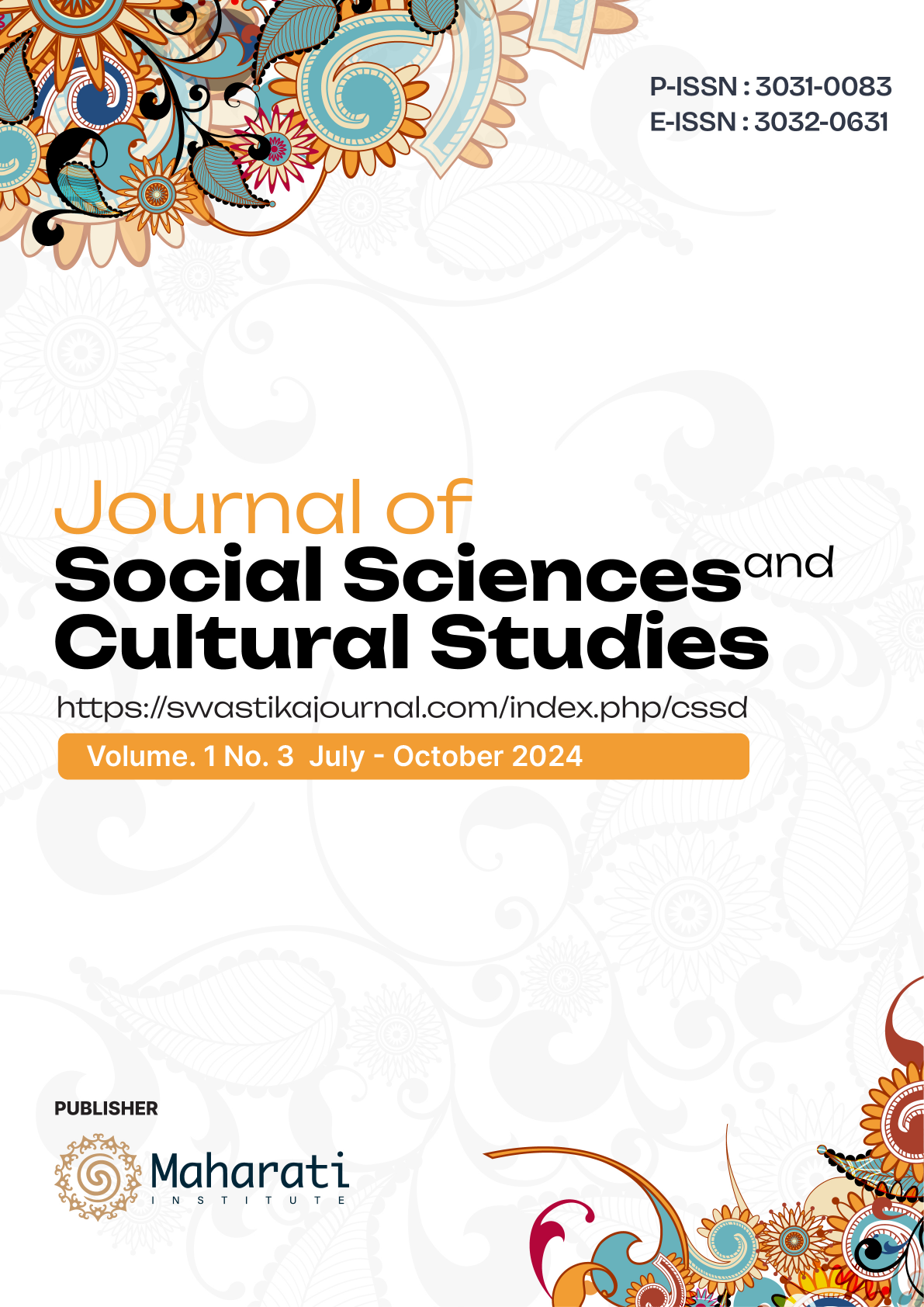The Psychological Horror & Psychoanalysis
DOI:
https://doi.org/10.61857/jsscs.v1i2.91Keywords:
Psychological Horror, Horror genre, PsychoanalysisAbstract
The horror genre is widely appreciated for its ability to challenge audiences through fear, offering suspense and excitement. Among its subgenres, psychological horror stands out for its unique focus on the mind, emotions, and internal struggles, rather than relying on direct confrontations with physical monsters or external threats. This subgenre delves into the complexities of the human psyche, often depicting mental illness and psychological tension to evoke fear. Unlike traditional horror, psychological horror builds suspense through atmosphere, character development, and the gradual unraveling of the protagonist's mental state, making it a subtler yet more unsettling form of horror. A literature review highlights how psychological horror has significantly shaped the portrayal of mental illness, offering deeper, more introspective representations of psychological disorders. The findings indicate that this subgenre's strength lies in its ability to present fear from a different perspective, often leaving much to the imagination of the audience, which intensifies the sense of dread. By focusing on internal fears and psychological conflicts, psychological horror provides a distinctive narrative experience, setting it apart from other horror subgenres that rely on physical confrontations. This makes it a compelling form of storytelling that resonates deeply with audiences, tapping into their subconscious fears and emotions
References
Baako, L. (2023). The Evolution of Horror Films: From Classic Monsters to Psychological Terrors. Art and Society, 2(5), 1–10. https://doi.org/10.56397/AS.2023.10.01
Biskind, P. (1983). Seeing is Believing: How I Learned to Stop Worrying and Love the Fifties. Pantheon Books. https://doi.org/10.1049/esn.1983.0041
Bordwell, D., & Thompson, K. (2019). Minding movies: observations on the art, craft, and business of filmmaking. University of Chicago Press.
Buday, J., Neumann, M., Heidingerová, J., Michalec, J., Podgorná, G., Mareš, T., Pol, M., Mahrík, J., Vranková, S., & Kališová, L. (2022). Depiction of mental illness and psychiatry in popular video games over the last 20 years. Frontiers in Psychiatry, 13, 967992. https://doi.org/10.3389/fpsyt.2022.967992
Church, D. (2021). Post-Horror: Art, Genre and Cultural Elevation. Edinburgh University Press. https://doi.org/10.3366/edinburgh/9781474475884.001.0001
Connolly, A. (2003). Psychoanalytic theory in times of terror. Journal of Analytical Psychology, 48(4), 407–431. https://doi.org/10.1111/1465-5922.00405
Dickens, E. G. (2017). An evaluation of mental health stigma perpetuated by Horror Video gaming. Young Res, 1(1), 108–117.
Ferrari, M., McIlwaine, S. V, Jordan, G., Shah, J. L., Lal, S., & Iyer, S. N. (2019). Gaming with stigma: analysis of messages about mental illnesses in video games. JMIR Mental Health, 6(5), e12418. https://doi.org/10.2196/12418
Freud, S. (1976). The" Uncanny". New Literary History, 7(3), 619. https://doi.org/10.2307/468561
Fuchs, T. (2019). The uncanny as atmosphere. Psychopathology and Atmospheres: Neither inside nor Outside, Newcastle upon Tyne, UK: Cambridge Scholars Publishing, 101–118.
Hightower, J. (2024). Mental Health Portrayals in Video Games and Their Impacts: Horror Games and their Reliance on the Mentally Ill.
Jancovich, M. (1992). Horror. B. T. Batsford.
Jancovich, M. (2015). ‘The theme of psychological destruction’: Horror stars, the crisis of identity and 1940s horror. Horror Studies, 6(2), 163–175. https://doi.org/10.1386/host.6.2.163_1
Jentsch, E. (1997). On the psychology of the uncanny (1906). Angelaki: Journal of the Theoretical Humanities, 2(1), 7–16. https://doi.org/10.1080/09697259708571910
Judytl. (2022). Psychological Horror. Writing Across Contexts.
Kalinowski, A. M. (2019). Silent Halls: PT, Freud, and Psychological Horror. Press Start, 5(1).
Kracauer, S. (2019). From Caligari to Hitler: A psychological history of the German film. Princeton University Press. https://doi.org/10.1515/9780691192086
Marak, K. (2014). Japanese and American Horror: A comparative study of film, fiction, graphic novels and video games. McFarland.
Marak, K. (2021). “If the dog dies, I quit”: Blair Witch and the problems of contemporary psychological horror games. Studia Humanistyczne AGH, 20(2), 57–70. https://doi.org/10.7494/human.2021.20.2.57
Mori, M., MacDorman, K. F., & Kageki, N. (2012). The uncanny valley [from the field]. IEEE Robotics & Automation Magazine, 19(2), 98–100. https://doi.org/10.1109/MRA.2012.2192811
Nummenmaa, L. (2021). Psychology and neurobiology of horror movies. https://doi.org/10.31234/osf.io/b8tgs
Prohászková, V. (2012). The genre of horror. American International Journal of Contemporary Research, 2(4), 132–142.
Santos, L. J. O. dos. (2022). The Horror Within: An Analysis of Psychological Horror Films’ Representation of Trauma Through Focalisation. uis.
Smith, B. (2015). Mental illness stigma in the media. The Review: A Journal of Undergraduate Student Research, 16(1), 50–63.
Smith, L. (2023). Creating tension through game-centric design in survival horror video games.
Spampinato, F. (2016). Body surrogates: Mannequins, life-size dolls, and avatars. PAJ: A Journal of Performance and Art, 38(2), 1–20. https://doi.org/10.1162/PAJJ_a_00311
Thomas, P. (2009). Catharsis. Historical Materialism, 17(3). https://doi.org/10.1163/146544609X12469428353220
Tomé, F., Pires, A., Jiskrová, A., Saial, A., & Campos, P. F. (2024). “I Found it Cathartic”: Exploring Empathy and Mental Health Awareness in Psychological Horror Video Games. Proceedings of the ACM on Human-Computer Interaction, 8(CHI PLAY), 1–21.
Tudor, A. (2002). Why horror. The Peculiar Pleasures of a Popular Genre. Washington.
Vorobeva, E. (2024). Building atmosphere in a horror game through environment design.
Wahl, O. (2003). Depictions of mental illnesses in children’s media. Journal of Mental Health, 12(3), 249–258. https://doi.org/10.1080/0963823031000118230
Wendykowska, E. (2012). American culture and perception of women in horror movies.
Windsor, M. (2019). What is the Uncanny? The British Journal of Aesthetics, 59(1), 51–65. https://doi.org/10.1093/aesthj/ayy028
Younis, A., & Fedtke, J. (2024). “You’ve been living here for as long as you can remember”: trauma in OMORI’s environmental design. Games and Culture, 19(3), 309–336. https://doi.org/10.1177/15554120231162982
Downloads
Published
Issue
Section
License
Copyright (c) 2024 Gray Hansen LIMANTORO, Yeyen Dwi ATMA

This work is licensed under a Creative Commons Attribution-NonCommercial 4.0 International License.
Creative Commons Attribution-NonCommercial 4.0 International License.














